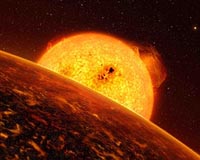|
|
|
How Do We Know That Planets Exist Outside Our Solar System Bonn, Germany (SPX) Oct 13, 2009  Even in ancient times, people observed the planets that orbit our Sun. (See also the astronomy question from week 1: Why are there seven days in a week?) Nowadays we know that there are many trillions of other stars in the Universe, in addition to the Sun. It seems likely that planets orbit many of these stars too. The evidence that extrasolar planets (exoplanets for short) exist was ... read more
Even in ancient times, people observed the planets that orbit our Sun. (See also the astronomy question from week 1: Why are there seven days in a week?) Nowadays we know that there are many trillions of other stars in the Universe, in addition to the Sun. It seems likely that planets orbit many of these stars too. The evidence that extrasolar planets (exoplanets for short) exist was ... read moreNASA Spacecraft Impacts Lunar Crater In Search For Water Ice  Moffett Field CA (SPX) Oct 12, 2009
Moffett Field CA (SPX) Oct 12, 2009NASA's Lunar Crater Observation and Sensing Satellite, or LCROSS, created twin impacts on the moon's surface early Friday in a search for water ice. Scientists will analyze data from the spacecraft's instruments to assess whether water ice is present. The satellite traveled 5.6 million miles during an historic 113-day mission that ended in the Cabeus crater, a permanently shadowed region ... more
|
Vietnam says parched Red River at record low
China to be world's third biggest wind power producer: media Cost-cutting NASA eyes three cheap space missions Honduras declares state of emergency amid drought Russia in secret plan to save Earth from asteroid: official Sarkozy scrambles to salvage carbon tax French carbon tax ruled illegal Brazil's Lula signs law cutting CO2 emissions 2009 a 'benign' year of natural disasters: German re-insurer Greenpeace Spain demands Denmark release its director
| |||||||||||||||
| Previous Issues | Oct 12 | Oct 09 | Oct 08 | Oct 07 | Oct 06 |
| . |
UBC Engineering Students Unveil Moon Dust-Shoveling Robot Vancouver, Canada (SPX) Oct 12, 2009
Vancouver, Canada (SPX) Oct 12, 2009A robot designed by UBC students will be shoveling moon dust at an international robotics competition next week, vying for a $500,000 prize and the opportunity to contribute to NASA's future space exploration projects. The UBC team has created a robotic machine that can excavate simulated lunar soil (regolith). Excavating regolith will be an important part of any construction project or ... more Hubble Observes LCROSS Impact Event  Pasadena CA (SPX) Oct 12, 2009
Pasadena CA (SPX) Oct 12, 2009NASA's Hubble Space Telescope has made a series of observations immediately preceding and following the Lunar Crater Observation and Sensing Satellite (LCROSS) Centaur rocket stage and shepherding spacecraft impacts at the lunar south pole, on October 9 at 7:31 and 7:35 a.m. EDT. Hubble's Wide Field Camera 3 (WFC3) and Space Telescope Imaging Spectrograph (STIS) were pointed just off the ... more NASA blasts moon with rocket in search for water  Washington (AFP) Oct 9, 2009
Washington (AFP) Oct 9, 2009The United States successfully blasted a rocket into the moon on Friday, slamming it into a crater near the lunar south pole in a bid to discover water, US space agency NASA said. No light flash was visible in the thermal images broadcast on NASA television, as the 2.3-tonne rocket impacted the Cabeus crater at 1131 GMT. A second shepherding spacecraft flew through the debris plume, coll ... more |
. |
| . |
NASA Refines Asteroid Apophis' Path Toward Earth Pasadena CA (SPX) Oct 08, 2009
Pasadena CA (SPX) Oct 08, 2009Using updated information, NASA scientists have recalculated the path of a large asteroid. The refined path indicates a significantly reduced likelihood of a hazardous encounter with Earth in 2036. The Apophis asteroid is approximately the size of two-and-a-half football fields. The new data were documented by near-Earth object scientists Steve Chesley and Paul Chodas at NASA's Jet ... more Microwaving Water From Moondust  Huntsville AL (SPX) Oct 08, 2009
Huntsville AL (SPX) Oct 08, 2009NASA is figuring out how to make water from moondust. Sounds like magic? "No magic--" says Ed Ethridge of NASA's Marshall Space Flight Center "-- just microwaves. We're showing how microwaves can extract water from moondust by heating it from the inside out." The recent discovery of water on the Moon's surface has inspired researchers like Ethridge to rev up the development of technologies ... more Goddard Visualization Team Previews Lunar Impact  Greenbelt MD (SPX) Oct 09, 2009
Greenbelt MD (SPX) Oct 09, 2009At 7:30 a.m. EDT on October 9, a two-ton rocket body will slam into a crater near the moon's south pole. By studying the resulting plume of gas and dust, scientists hope this grand experiment will confirm the presence of ice in permanently shadowed craters at the lunar poles. The event is the highlight of NASA's Lunar Crater Observation and Sensing Satellite (LCROSS) mission. The LCROSS ... more |
. |
| Previous Issues | Oct 12 | Oct 09 | Oct 08 | Oct 07 | Oct 06 |
| The contents herein, unless otherwise known to be public domain, are Copyright 1995-2009 - SpaceDaily. AFP and UPI Wire Stories are copyright Agence France-Presse and United Press International. ESA Portal Reports are copyright European Space Agency. All NASA sourced material is public domain. Additional copyrights may apply in whole or part to other bona fide parties. Advertising does not imply endorsement, agreement or approval of any opinions, statements or information provided by SpaceDaily on any web page published or hosted by SpaceDaily. Privacy statement |